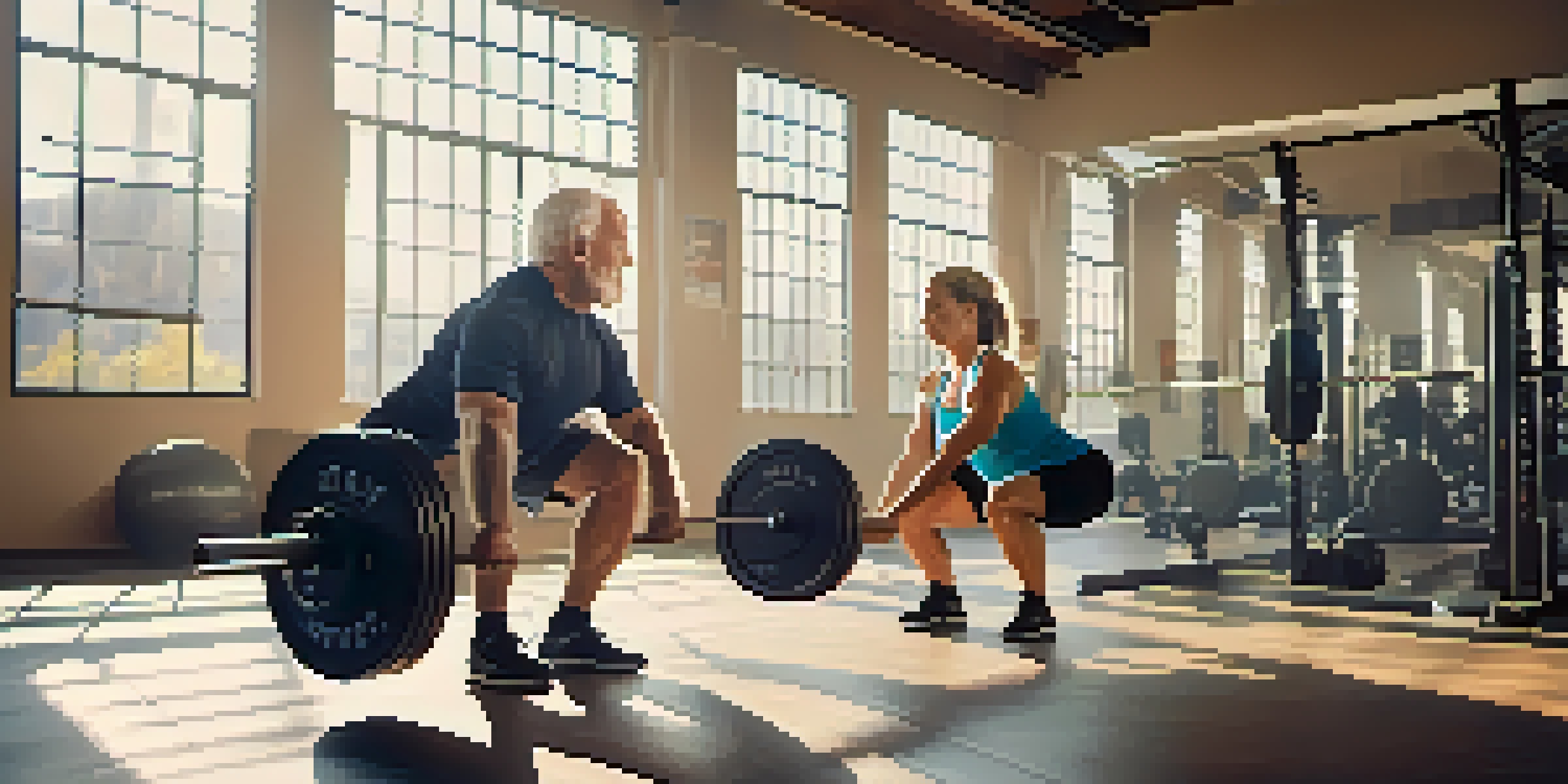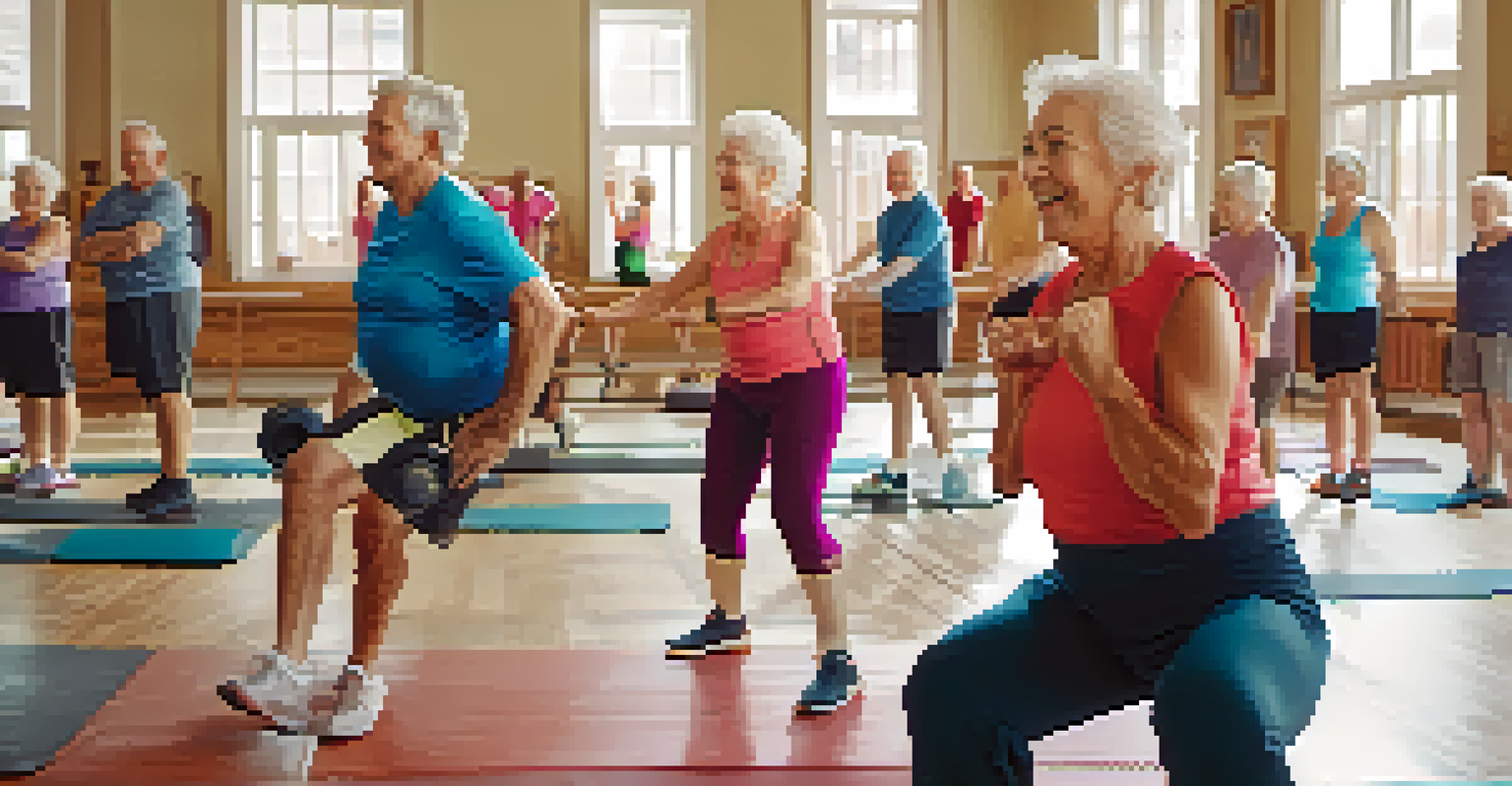Powerlifting Techniques for Seniors: Safe Practices

Understanding Powerlifting: A Senior’s Perspective
Powerlifting is a strength sport that focuses on three main lifts: the squat, bench press, and deadlift. For seniors, engaging in powerlifting can enhance muscle strength, improve bone density, and boost overall health. However, it’s essential to adapt techniques to suit the unique needs and capabilities of older adults. Understanding the basic principles of powerlifting can make the practice both safe and enjoyable.
Strength does not come from physical capacity. It comes from an indomitable will.
As we age, our bodies undergo various changes, including muscle loss and decreased flexibility. This makes it crucial for seniors to approach powerlifting with mindfulness and proper technique. By focusing on form rather than heavy weights, older adults can build strength without risking injury. This foundational knowledge sets a positive tone for the rest of the powerlifting journey.
Seniors should also consider their individual health conditions and consult with a healthcare provider before starting any powerlifting routine. Knowing one’s limits and working within them is key to enjoying the benefits of this empowering sport. So, let’s delve deeper into safe practices that can help seniors lift effectively and confidently.
Essential Warm-Up Techniques for Seniors
Warming up is a crucial step in any workout, especially for seniors engaging in powerlifting. A proper warm-up routine increases blood flow to the muscles and enhances flexibility, reducing the risk of injury. Simple movements like arm circles, leg swings, and gentle stretches can prepare the body for lifting. These exercises should be performed at a comfortable pace, tailored to individual fitness levels.

Dynamic stretching is particularly beneficial for seniors as it helps maintain mobility. For example, walking lunges and torso twists can activate the major muscle groups used in powerlifting. Engaging in a warm-up not only helps prevent injuries but also mentally prepares individuals for their workout. It’s like revving up a car engine before hitting the road—essential for smooth performance.
Powerlifting Benefits for Seniors
Powerlifting enhances muscle strength, bone density, and overall health for seniors when approached with proper techniques.
Seniors should take their time with warm-ups, allowing for at least 10-15 minutes of preparation before lifting. Each person’s body responds differently, so listening to one’s body during this phase is vital. Proper warm-ups can make a significant difference in how well seniors perform their lifts, leading to a safer and more effective workout.
Choosing the Right Equipment for Safe Lifting
Selecting the right equipment is critical for seniors engaging in powerlifting. Proper footwear, like weightlifting shoes with a flat sole, provides stability and support during lifts. A good pair of shoes can help maintain balance and improve performance, making it easier to lift safely. Additionally, using a weightlifting belt can offer extra support for the lower back, especially during heavy lifts.
The greatest glory in living lies not in never falling, but in rising every time we fall.
Resistance bands and lighter weights are excellent tools for seniors to start their powerlifting journey. These items can help build foundational strength without overwhelming the body. For instance, resistance bands can assist with squats and deadlifts, allowing seniors to focus on form while gradually increasing strength. Choosing the right equipment ensures that seniors feel confident and secure while lifting.
Seniors should also consider personal preferences and comfort when selecting equipment. Each individual has unique needs, and what works for one person may not work for another. By prioritizing comfort and safety in equipment choices, seniors can enjoy their lifting experience and minimize the risk of injury.
Mastering the Squat: Key Techniques for Seniors
The squat is one of the foundational lifts in powerlifting and offers numerous benefits for seniors. It strengthens the legs, hips, and core while promoting better balance and stability. To perform a squat safely, seniors should start with bodyweight squats before progressing to added weights. This gradual approach allows individuals to focus on mastering their form without straining their bodies.
When executing a squat, seniors should ensure their feet are shoulder-width apart and their chest remains up. It’s essential to keep the weight distributed evenly through the heels and to avoid letting the knees extend past the toes. Using a chair or bench can provide support during initial attempts, making it easier to achieve proper depth without compromising safety.
Importance of Safe Equipment Choices
Selecting appropriate equipment, such as supportive footwear and lighter weights, is essential for safe and effective powerlifting for seniors.
Incorporating squats into a regular routine can lead to significant improvements in mobility and strength. Seniors should aim to perform squats at least a couple of times a week, gradually increasing repetitions as they grow more comfortable. With practice, they can build confidence in their squatting abilities, making powerlifting a fulfilling part of their fitness journey.
The Bench Press: Safe Practices for Seniors
The bench press is another key lift in powerlifting, and it can be particularly beneficial for seniors looking to strengthen their upper body. This exercise targets the chest, shoulders, and triceps, enhancing overall upper body strength. As with any lift, seniors should start with lighter weights to ensure they can maintain proper form throughout the movement.
When preparing for the bench press, seniors should lie flat on their back with feet firmly planted on the ground. It’s vital to keep the shoulder blades retracted and the elbows tucked in during the lift. Using a spotter or performing the bench press on a Smith machine can enhance safety, providing an extra layer of security during the exercise. Safety should always be a priority, especially when lifting weights overhead.
Seniors can benefit from incorporating variations of the bench press, such as incline or decline presses, to target different muscle groups. These alternatives can keep workouts fresh and engaging while promoting balanced strength development. As seniors gain confidence in their bench press technique, they can gradually increase their weights, enjoying the journey of strength-building.
Deadlifts: Techniques for Safe Lifting
Deadlifts are a powerful exercise that can enhance back strength and overall stability, making them a great addition to a senior's powerlifting routine. This lift primarily targets the back, hamstrings, and glutes. To perform a deadlift safely, seniors should start with light weights or even just a barbell to focus on their form. Proper technique is crucial to prevent injury and maximize benefits.
When preparing to lift, seniors should stand with their feet hip-width apart and grip the bar just outside their knees. It’s essential to keep the back straight and engage the core throughout the movement. As they lift, seniors should push through their heels, keeping the bar close to their body. This approach helps maintain balance and prevents excessive strain on the lower back.
Listening to Your Body Matters
Seniors should prioritize listening to their bodies and adjusting their routines to promote safe and sustainable strength-building.
Incorporating deadlifts into regular workouts can lead to improved posture and functional strength. Seniors should aim to practice deadlifts once or twice a week, gradually increasing weights as they progress. With patience and consistency, deadlifts can become a rewarding part of a senior's strength training routine.
Listening to Your Body: Key to Safe Powerlifting
One of the most important aspects of powerlifting, especially for seniors, is listening to your body. It’s essential to be attuned to how you feel during and after workouts. If something doesn’t feel right, whether it’s pain or excessive fatigue, it’s crucial to take a step back and reassess. Remember, building strength is a journey, and it’s okay to go at your own pace.
Seniors should prioritize rest days and recovery, allowing their bodies to heal and rebuild between workouts. Incorporating flexibility and mobility exercises can also aid in recovery, helping to reduce soreness and improve overall performance. It’s like tending to a garden; the more care you give it, the more it flourishes over time.

Regularly assessing progress and adjusting workouts based on how you feel can lead to more sustainable strength gains. Whether it’s modifying the number of sets, reps, or weights, being flexible with your routine can prevent burnout and injuries. By listening to their bodies, seniors can enjoy the benefits of powerlifting while minimizing risks.
Celebrating Progress: Staying Motivated in Powerlifting
Staying motivated is key to any fitness journey, and powerlifting is no exception. For seniors, celebrating small milestones can significantly enhance motivation. Whether it’s achieving a new personal best or simply mastering a technique, recognizing these accomplishments can foster a sense of pride and encourage continued effort. It’s like planting seeds and watching them grow; every small achievement is a step toward a flourishing garden.
Engaging with a community, whether in-person or online, can also provide support and inspiration. Sharing experiences with fellow lifters can create meaningful connections and offer encouragement along the way. Many seniors find motivation in group workouts or classes, where they can share their challenges and successes with others who understand their journey.
Lastly, setting realistic goals is crucial for maintaining motivation. Instead of focusing solely on the end result, seniors should aim for achievable targets along the way. By celebrating progress, connecting with others, and setting attainable goals, seniors can enjoy a fulfilling powerlifting experience that enhances both their physical and mental well-being.